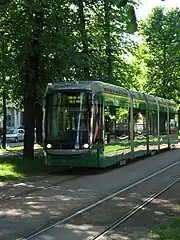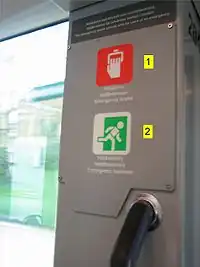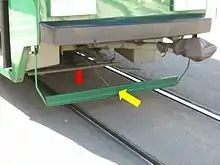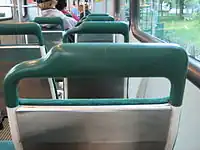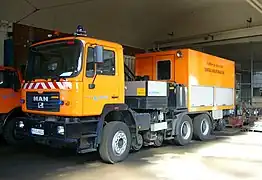A tram accident is any accident involving a tram or tram system.
Though tram systems can be environmentally friendly, efficient, and cost effective methods of transport within urban areas, issues such as poor maneuverability and long braking distances also pose public safety concerns.[2] Research indicates that for each kilometer traveled, trams are 12 times more likely to be involved in a serious accident than a car.[3]
Types of accidents
Tram derailments and collisions
Tram derailments are often caused by damaged track, collisions with obstacles such as other vehicles or pedestrians, junction failures, or excessive speed at a junction or curve. Additionally, collisions may occur between trams due to faulty junctions or poor driving.
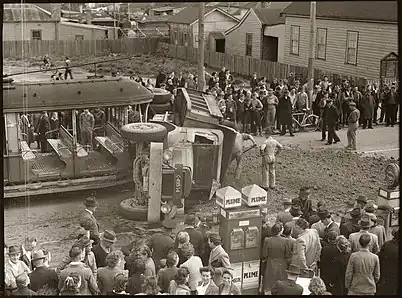
Passenger accidents
Trams coming to a sudden stop may cause injuries to passengers on board. Passengers may also slip, trip or fall on the tram or the tram platform. Blind passengers may particularly be at risk of falling off a tram or getting injured by closing doors. In areas of overcrowded tram systems, illegal passengers are in danger of falling off or being trapped between tram cars. Fire aboard a tram puts passengers at risk of severe injury or death.
Additionally, passengers may be struck by a car while exiting the tram or while waiting at a tram platform. Such incidents are also taken into account during tram public safety studies.
Pedestrians and cyclists
While collisions with cars are the most common form of tram accident, cyclists and pedestrians are the group most at risk of death during tram collisions. Cyclists may experience a loss of control if bicycle tires get jammed in tramway tracks.[4] More rarely, members of the public may also climb over a tram car, or in other ways get in contact with the electric conductors or other electric appliances of a tram, and receive an electric shock.
The mortality of pedestrians hit by a tram seems to be much higher than the mortality of pedestrians hit by a motor vehicle. Typically most seriously injured people have been caught under or between tramcars.[5] Non-impact absorbing parts at the side of the trams may lead to serious head injuries even at low speeds.[6]
Accident analysis
In some countries accident investigation boards investigate all rail accidents and hazardous situations that may have led to a serious accident. These investigations are detailed analysis on the causes and consequences of the accidents. Investigations create information and recommendations to prevent further accidents. The investigations can be required by law with systematic guides determining minimum requirements for an analysis. In addition, rail accident investigations can analyze previous occurrences of a similar character.[7]
Some national authorities keep statistics on tramway incidents.[8][9] An example of an authority collecting accident and incident reports from national authorities is the European Railway Agency, which keeps a public safety database on railway licences, certificates, safety indicators, national safety rules, and accident investigations.[10] In the European Union, the safety of railways has been regulated with directives, which also require the collection of common safety indicator statistics from member countries. In the EU, common safety methods (CSMs) and common safety targets (CSTs) have been set for European railways.
Safety measures
Tram stops
When evaluating general traffic safety, the safety of tram lines and train and tram crossings are given particular attention.[11] Some cities or areas have systemically developed new safety systems and planned new, safer tram stops. These measures have included accessible tram stops, safety staff, road-based improvements like speed humps near tram stops, better lighting of tram stops, raised dividing strips to separate trams and motorists, traffic light sequence changes, speed limit changes near tram stops, and electronic flashing "give way to trams" signs to warn other traffic in places where necessary[12][13][14][15][16] Tram stops have also been separated with barriers from the street in some locations.[6]
Tram design
Structural design of trams can minimize the risks to tram drivers, tram passengers, pedestrians, and passengers in other vehicles in various kinds of tram-to-tram, tram-to-vehicle, and tram-to-pedestrian collisions.[17]
For example, some trams contain emergency brakes for passengers to access. Both icy winters and falling leaves pose a threat by making the rails more slippery. Therefore, some trams are also able to drop sand on the rails to increase the friction during emergency braking. A brush car can be used to clear the rails.[18]
Automatic door controlling sensors also decrease the possibility of entrapment injuries. In Toronto, the CLRV streetcars have a skirt added to the front of the car covering the coupler to prevent passengers from being dragged under the car's wheels. Common safety features onboard tram often include driver's vigilance control systems and programmable logic speed controllers.[19] A tram also typically carries first aid kit, a radio and/or a phone, some tools, and a fire extinguisher.
Tram control centres
A quality system may guide the safety of a tram system. A tram system may have a control centre following the trams, having radio contact with the drivers, and ability to contact and guide guards, emergency dispatch centre, or repair patrols.
Education
Tram drivers
Basic first aid, safety courses, and protocols to follow in an accident are taught to tram drivers. Some organizations test the drivers for alcohol and/or drugs regularly to avoid driving under the influence. The health of the drivers may also be assessed regularly or in case of need. Some organizations also give education to drivers and re-evaluate their skills and manners periodically.
Rescue teams
Rescue organizations are also informed on tram structures, electricity, risks, and specific rescue and firefighting tactics concerning trams. Rescue organizations may also train with trams in simulated accident and firefighting situations.
General public
Various cities and traffic companies have given safety and traffic instructions for passengers, pedestrian, wheelchair users, cyclists, and motorists.[20][21][22] These instructions tell how to behave in traffic to avoid accidents. For example, the instructions advise not to obstruct the tramway, suggest motorists avoid driving directly on the track, and tell the pedestrians to use designated crossways and to look both ways before crossing the tracks. Local tram regulations may give requirements for the passengers not to carry flammable, soiling, or destructive chemicals or space-blocking packages in trams.[23] Enlightenment of children and adults have also been done by using games and tests.[24]
Accident protocol
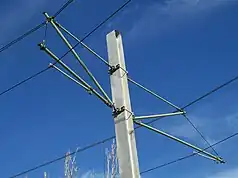
Emergency dispatch centres have strategies and emergency response guides prepared for various kinds of tram accidents. These response guides can contain information on what emergency response units (police, ambulance, fire apparatus, investigation units etc.) are sent to the accident scene in various kind of accidents (fire, derailment, collision, pedestrian hit by a tram etc.).
At the accident scene, a ground connection is used to prevent electric shocks from overhead lines. The accident scene is surveyed, and in the case of several injured persons, a triage process or other recognition of patients' states is done. The most critically injured patients are the first to receive attention and treatment. Hospitals can also be alerted in major accidents.
In the case of someone underneath a tram, lifting bags or hydraulic jacks brought by fire brigades can be used to elevate the tram and release anyone trapped under the vehicle. A crane can also be used to lift a tram or an overturned tram. If a patient is trapped inside crushed structures, various kinds of extrication tools, like hydraulic spreaders, rams, cutters, and circular saws can be used. In some cases, it is also possible to drive the tram backwards, but in most cases this would only cause more injuries to the victim. While cutting, lifting or turning an overturned tram or vehicle, structures often have to be stabilized to mitigate the risk of moving parts, and to secure suspended vehicles or objects.
Cranes, tow trucks, hydraulic jacks and rollers can be used to rerail a derailed tram vehicle.
After the patients have been treated and transported, police inquiries may take place. After a full inspection, the vehicles involved may be allowed leave the scene. In severe accidents, special traffic or accident investigation boards may analyze the accident and its consequences, and give recommendations to improve safety in traffic. After the accident, the tram, the tracks and the overhead lines may also need repair.
See also
References
- ↑ "FREQUENTLY ASKED QUESTIONS – TRAM DRIVER" (PDF). Yarra Trams. Archived from the original (PDF) on 18 April 2015.
- ↑ "Traffic safety of tram transport" (PDF). Norwegian Institute of Transport Economics. 1997. p. 1. Retrieved 18 April 2015.
- ↑ "Meer veiligheid nodig voor bus en tram". NU. 10 February 2011.
- ↑ Ozanne-Smith J., and Sherry K.: Bicycle related injuries. Hazard, Edition No. 6, December 1990. Victorian Injury Surveillance System. http://www.campusglobal.org/muarc/VISU/hazard/haz06.pdf. Retrieved 26 June 2007.
- ↑ Hedelin Annika, Björnstig Ulf, and Brismar, Bo: Trams – a risk factor for pedestrians. Accid. Anal. and Prev. Vol. 28, No. 6, pp. 733–738, 1996.
- 1 2 Unger R., Eder C., Mayr J.M., and Wernig J.: Child pedestrian injuries at tram and bus stops. Injury Vol. 33, Issue 6, pp. 485–488, July 2002.
- ↑ Derailment of a tram at Phipps Bridge on the Croydon Tramlink 25 May 2006. Rail Accident Report 28/2007. Rail Accident Investigation Branch, Department for Transport, August 2007. Crown copyright 2007. http://www.raib.gov.uk/cms_resources.cfm?file=/070808_R282007_PhippsBridge.pdf (retrieved on 6 February 2009).
- ↑ For example, Annual Report on Railway Safety 2005. Office of Rail Regulation, London, the UK. http://www.rail-reg.gov.uk/upload/pdf/296.pdf. Retrieved 8 July 2007.
- ↑ In the Netherlands: TRAMS-database by the Dutch Transport Safety Board. Mentioned in: P. Thomas, Y. Page, G. Vallet, D. Otte, R. Sferco, G. Della Valle, M. Giunti, B. Hoogvelt, J. Paez, P. Magnusson, and R. Cuerden: Status report of EEVC WG 21 Accident Studies. "Archived copy" (PDF). Archived from the original (PDF) on 20 November 2008. Retrieved 7 February 2010.
{{cite web}}: CS1 maint: archived copy as title (link) (retrieved on 7 February 2010). - ↑ "European Railway Agency". European Union Agency for Railways. 18 November 2005. Archived from the original on 25 November 2005. Retrieved 26 May 2023.
{{cite web}}: CS1 maint: unfit URL (link) - ↑ Irk F.: CPTED Principles for Traffic Safety. In: Proceedings, 2003 International Symposium on Technology and Society, 2003. Crime Prevention, Security and Design. ISTAS/CPTED 2003. 26–28 Sep 2003 pp. 41–43. http://ieeexplore.ieee.org/iel5/9312/29612/01344610.pdf?tp=&isnumber=&arnumber=1344610. Retrieved 26 June 2007.
- ↑ Oxley J., Corben B., and Diamantopoulou K.: Some cost-effective approaches to moderate vehicle speeds in high pedestrian activity environments. http://www.rsconference.com/pdf/RS010023.pdf?check=1. Retrieved 26 June 2007.
- ↑ The Department of Infrastructure, Victoria: Safe Travel. "Public transport - Safe travel". Archived from the original on 20 May 2009. Retrieved 6 February 2010. retrieved on 8 July 2007.
- ↑ VicRoads: Think tram. "Think tram : VicRoads". Archived from the original on 11 August 2007. Retrieved 8 July 2007. retrieved on 8 July 2007.
- ↑ VicRoads: Think tram projects. http://www.vicroads.vic.gov.au/Home/PublicTransportAndEnvironment/PublicTransportOnRoads/TramProjects/ThinkTram/ThinkTramProjects.htm. Retrieved 8 July 2007.
- ↑ An Overview of Current Research Project at the Institute of Transport Studies Dept. of Civil Engineering Monash University. Paper presented at 28th CAITR on 6–8 December 2006. http://civil.eng.monash.edu.au/its/researchactivities/itsmonash_research_projects_2006.pdf. Retrieved 8 July 2007.
- ↑ George Rechnitzer, Andrew McIntosh, Shane Richardson, Raphael Grzebieta, and Jeffery Jaraie: Crashworthiness Improvements For Light And Heavy Rail – Lessons Learnt From Crash Investigations. http://www.regulations.gov/search/Regs/contentStreamer?objectId=0900006480409c40&disposition=attachment&contentType=pdf (retrieved on 6 February 2009)
- ↑ Lehtikeli liukastaa ratikkakiskot. Helsingin kaupungin liikennelaitos, ajankohtaista 25.10.06. Article by Helsinki City Traffic in Finnish.
- ↑ Hongkong Tramways Limited: Safety and Reliability are our Top Priorities. In: The Company. "Hongkong Tramways". Archived from the original on 10 April 2008. Retrieved 29 April 2008.. Retrieved 8 July 2007.
- ↑ For example, BBC: Idiot’s Guide to tram safety. In: Where I live: Nottingham. January 2004. http://www.bbc.co.uk/nottingham/features/2004/01/idiots_guide_to_tram_safety.shtml retrieved on 8 July 2007.
- ↑ AA Roadwatch: Rail information – Road user safety. http://www.aaroadwatch.ie/rail/luas_guidelines.asp. Retrieved 8 July 2007.
- ↑ Supertram: Supertram & Community – Safety. http://www.supertram.com/safety.html. Retrieved 8 July 2007
- ↑ Portland aerial tram regulations. http://www.portlandtram.org/download.cfm?file=/downloads/pdf/TramregulationsfinalapprovedbyEMC.pdf. Retrieved 8 July 2007.
- ↑ For example, The Tracking Trains safety pages of Rail Corporation of NSW in Australia. http://www.trackingtrains.com.au/activities/safe_tracks.htm. Retrieved 8 July 2007
